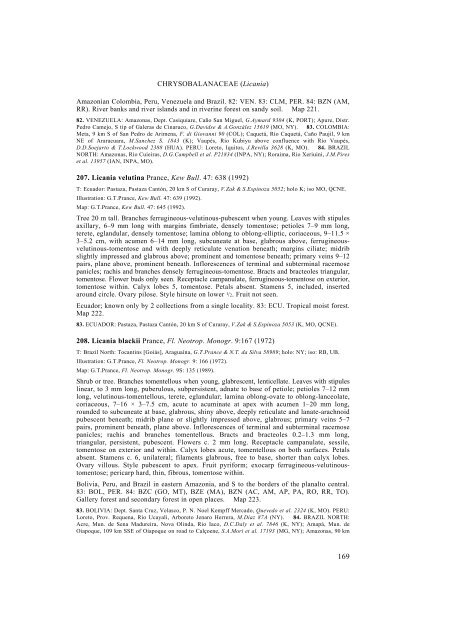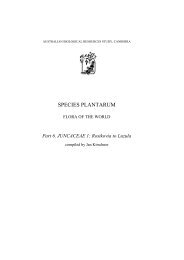Vol. 1 part 2 - Species Plantarum Programme
Vol. 1 part 2 - Species Plantarum Programme
Vol. 1 part 2 - Species Plantarum Programme
You also want an ePaper? Increase the reach of your titles
YUMPU automatically turns print PDFs into web optimized ePapers that Google loves.
CHRYSOBALANACEAE (Licania)<br />
Amazonian Colombia, Peru, Venezuela and Brazil. 82: VEN. 83: CLM, PER. 84: BZN (AM,<br />
RR). River banks and river islands and in riverine forest on sandy soil. Map 221.<br />
82. VENEZUELA: Amazonas, Dept. Casiquiare, Caño San Miguel, G.Aymard 9304 (K, PORT); Apure, Distr.<br />
Pedro Camejo, S tip of Galeras de Cinaruco, G.Davidse & A.González 15619 (MO, NY). 83. COLOMBIA:<br />
Meta, 9 km S of San Pedro de Arimena, F. di Giovanni 90 (COL); Caquetá, Río Caquetá, Caño Paujil, 9 km<br />
NE of Araracuara, M.Sanchez S. 1843 (K); Vaupés, Río Kubiyu above confluence with Río Vaupés,<br />
D.D.Soejarto & T.Lockwood 2388 (HUA). PERU: Loreto, Iquitos, J.Revilla 3628 (K, MO). 84. BRAZIL<br />
NORTH: Amazonas, Rio Cuieiras, D.G.Campbell et al. P21834 (INPA, NY); Roraima, Rio Xeriuini, J.M.Pires<br />
et al. 13957 (IAN, INPA, MO).<br />
207. Licania velutina Prance, Kew Bull. 47: 638 (1992)<br />
T: Ecuador: Pastaza, Pastaza Cantón, 20 km S of Curaray, V.Zak & S.Espinoza 5052; holo K; iso MO, QCNE.<br />
Illustration: G.T.Prance, Kew Bull. 47: 639 (1992).<br />
Map: G.T.Prance, Kew Bull. 47: 645 (1992).<br />
Tree 20 m tall. Branches ferrugineous-velutinous-pubescent when young. Leaves with stipules<br />
axillary, 6–9 mm long with margins fimbriate, densely tomentose; petioles 7–9 mm long,<br />
terete, eglandular, densely tomentose; lamina oblong to oblong-elliptic, coriaceous, 9–11.5 ×<br />
3–5.2 cm, with acumen 6–14 mm long, subcuneate at base, glabrous above, ferrugineousvelutinous-tomentose<br />
and with deeply reticulate venation beneath; margins ciliate; midrib<br />
slightly impressed and glabrous above; prominent and tomentose beneath; primary veins 9–12<br />
pairs, plane above, prominent beneath. Inflorescences of terminal and subterminal racemose<br />
panicles; rachis and branches densely ferrugineous-tomentose. Bracts and bracteoles triangular,<br />
tomentose. Flower buds only seen. Receptacle campanulate, ferrugineous-tomentose on exterior,<br />
tomentose within. Calyx lobes 5, tomentose. Petals absent. Stamens 5, included, inserted<br />
around circle. Ovary pilose. Style hirsute on lower 1 /2. Fruit not seen.<br />
Ecuador; known only by 2 collections from a single locality. 83: ECU. Tropical moist forest.<br />
Map 222.<br />
83. ECUADOR: Pastaza, Pastaza Cantón, 20 km S of Curaray, V.Zak & S.Espinoza 5053 (K, MO, QCNE).<br />
208. Licania blackii Prance, Fl. Neotrop. Monogr. 9:167 (1972)<br />
T: Brazil North: Tocantins [Goiás], Araguaína, G.T.Prance & N.T. da Silva 58989; holo: NY; iso: RB, UB.<br />
Illustration: G.T.Prance, Fl. Neotrop. Monogr. 9: 166 (1972).<br />
Map: G.T.Prance, Fl. Neotrop. Monogr. 9S: 135 (1989).<br />
Shrub or tree. Branches tomentellous when young, glabrescent, lenticellate. Leaves with stipules<br />
linear, to 3 mm long, puberulous, subpersistent, adnate to base of petiole; petioles 7–12 mm<br />
long, velutinous-tomentellous, terete, eglandular; lamina oblong-ovate to oblong-lanceolate,<br />
coriaceous, 7–16 × 3–7.5 cm, acute to acuminate at apex with acumen 1–20 mm long,<br />
rounded to subcuneate at base, glabrous, shiny above, deeply reticulate and lanate-arachnoid<br />
pubescent beneath; midrib plane or slightly impressed above, glabrous; primary veins 5–7<br />
pairs, prominent beneath, plane above. Inflorescences of terminal and subterminal racemose<br />
panicles; rachis and branches tomentellous. Bracts and bracteoles 0.2–1.3 mm long,<br />
triangular, persistent, pubescent. Flowers c. 2 mm long. Receptacle campanulate, sessile,<br />
tomentose on exterior and within. Calyx lobes acute, tomentellous on both surfaces. Petals<br />
absent. Stamens c. 6, unilateral; filaments glabrous, free to base, shorter than calyx lobes.<br />
Ovary villous. Style pubescent to apex. Fruit pyriform; exocarp ferrugineous-velutinoustomentose;<br />
pericarp hard, thin, fibrous, tomentose within.<br />
Bolivia, Peru, and Brazil in eastern Amazonia, and S to the borders of the planalto central.<br />
83: BOL, PER. 84: BZC (GO, MT), BZE (MA), BZN (AC, AM, AP, PA, RO, RR, TO).<br />
Gallery forest and secondary forest in open places. Map 223.<br />
83. BOLIVIA: Dept. Santa Cruz, Velasco, P. N. Noel Kempff Mercado, Quevedo et al. 2324 (K, MO). PERU:<br />
Loreto, Prov. Requena, Río Ucayali, Arboreto Jenaro Herrera, M.Diaz 87A (NY). 84. BRAZIL NORTH:<br />
Acre, Mun. de Sena Madureira, Nova Olinda, Rio Iaco, D.C.Daly et al. 7846 (K, NY); Amapá, Mun. de<br />
Oiapoque, 109 km SSE of Oiapoque on road to Calçoene, S.A.Mori et al. 17193 (MG, NY); Amazonas, 90 km<br />
169












